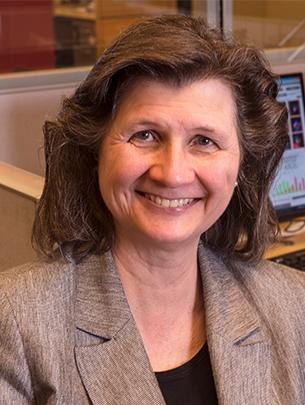 Using health data to understand disease and wellness as well as the best treatment and prevention options forpatients, is critical for improving care. That’s why VA is partnering with the National Cancer Institute’s Center for Strategic Scientific Initiatives to use “big data” to advance favorable outcomes in patient care. “Big data” in health care is a term used to describe complex and very large data sets that have evolved since the inception of electronic health records.
Using health data to understand disease and wellness as well as the best treatment and prevention options forpatients, is critical for improving care. That’s why VA is partnering with the National Cancer Institute’s Center for Strategic Scientific Initiatives to use “big data” to advance favorable outcomes in patient care. “Big data” in health care is a term used to describe complex and very large data sets that have evolved since the inception of electronic health records.
 The Genomic Data Commons, a next-generation platform that enables unprecedented data access, analysis and sharing for cancer research, publicly launched at the University of Chicago on June 6, opening the door to discoveries for this complex set of diseases. The Genomic Data Commons went live with approximately 4.1 petabytes of data from National Cancer Institute-supported research programs, including some of the largest and most comprehensive cancer genomics datasets in the world...
The Genomic Data Commons, a next-generation platform that enables unprecedented data access, analysis and sharing for cancer research, publicly launched at the University of Chicago on June 6, opening the door to discoveries for this complex set of diseases. The Genomic Data Commons went live with approximately 4.1 petabytes of data from National Cancer Institute-supported research programs, including some of the largest and most comprehensive cancer genomics datasets in the world...
 Neurosurgeons must avoid cutting into parts of the brain responsible for key functions such as language (orange) and vision (green), but individuals vary in where such functions are located (each of the top images compared with the bottom images above). Researchers are creating a software program that uses data from MRI scans to create personalized anatomic and functional brain maps and integrate them into a navigational system to guide physicians during neurosurgery. Removing a brain tumor requires walking a fine line: Remove too little, and the disease remains; remove too much, and sight, speech or movement may be impaired...
Neurosurgeons must avoid cutting into parts of the brain responsible for key functions such as language (orange) and vision (green), but individuals vary in where such functions are located (each of the top images compared with the bottom images above). Researchers are creating a software program that uses data from MRI scans to create personalized anatomic and functional brain maps and integrate them into a navigational system to guide physicians during neurosurgery. Removing a brain tumor requires walking a fine line: Remove too little, and the disease remains; remove too much, and sight, speech or movement may be impaired... A corporate-government partnership to improve U.S. veterans’ access to personalized cancer treatments will highlight a nationwide series of gatherings and events Wednesday detailing of Vice President Joe Biden’s “Cancer Moonshot” program. IBM Corp. will donate access to its “Watson” supercomputer -- best known for beating human champions on the television game show “Jeopardy!” -- to the U.S. Department of Veterans Affairs. The supercomputer will help provide facilitate oncology treatment for those who have served in the U.S. military, according to a statement from the White House...
A corporate-government partnership to improve U.S. veterans’ access to personalized cancer treatments will highlight a nationwide series of gatherings and events Wednesday detailing of Vice President Joe Biden’s “Cancer Moonshot” program. IBM Corp. will donate access to its “Watson” supercomputer -- best known for beating human champions on the television game show “Jeopardy!” -- to the U.S. Department of Veterans Affairs. The supercomputer will help provide facilitate oncology treatment for those who have served in the U.S. military, according to a statement from the White House... How can six and half feet of DNA be folded into the tiny nucleus of a cell? Researchers funded by the National Institutes of Health have developed a new imaging method that visualizes a very different DNA structure, featuring small folds of DNA in close proximity. The study reveals that the DNA-protein structure, known as chromatin, is a much more diverse and flexible chain than previously thought. This provides exciting new insights into how chromatin directs a nimbler interaction between different genes to regulate gene expression, and provides a mechanism for chemical modifications of DNA to be maintained as cells divide...
How can six and half feet of DNA be folded into the tiny nucleus of a cell? Researchers funded by the National Institutes of Health have developed a new imaging method that visualizes a very different DNA structure, featuring small folds of DNA in close proximity. The study reveals that the DNA-protein structure, known as chromatin, is a much more diverse and flexible chain than previously thought. This provides exciting new insights into how chromatin directs a nimbler interaction between different genes to regulate gene expression, and provides a mechanism for chemical modifications of DNA to be maintained as cells divide... A new center hosted at the University of Chicago-co-led by the largest medical imaging professional organizations in the country-will help tackle the ongoing COVID-19 pandemic by curating a massive database of medical images to help better understand and treat the disease. Led by Prof. Maryellen Giger of UChicago Medicine, the Medical Imaging and Data Resource Center (MIDRC) will create an open-source database with medical images from thousands of COVID-19 patients. The center will be funded by a two-year, $20 million contract from the National Institute of Biomedical Imaging and Bioengineering at the National Institutes of Health (NIH).
A new center hosted at the University of Chicago-co-led by the largest medical imaging professional organizations in the country-will help tackle the ongoing COVID-19 pandemic by curating a massive database of medical images to help better understand and treat the disease. Led by Prof. Maryellen Giger of UChicago Medicine, the Medical Imaging and Data Resource Center (MIDRC) will create an open-source database with medical images from thousands of COVID-19 patients. The center will be funded by a two-year, $20 million contract from the National Institute of Biomedical Imaging and Bioengineering at the National Institutes of Health (NIH).